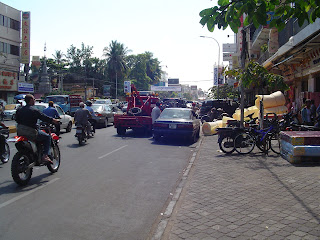Today (14 December, 2006) from the Cambodian Daily a rather endearing story about an opposition party legislator / parliamentarian and the obvious way to treat a traffic victim. Obvious as there is the age old Cambodian traditional tendency to either blame the victim (and claim compensation) or to do a hit-and-run and pay for the funeral expenses (if public opinion sees this necessary). Another possibility is to a paper-scissors-rock game with one of the possibilities exchanged by a pistol or something more menacing. Hankies ready?
Lawmaker Apologizes for Hitting Man With His Car
By Saing SoenthrithSRP lawmaker Cheam Channy has agreed to compensate a pedestrian after his car collided with the man in Phnom Penh on Tuesday evening, police and the lawmaker said Wednesday. Kun Sophal, 41, was crossing National Road 6 in Russei Keo districts Prek Leap commune at 7:30 pm when he was struck by a Toyota Camry driven by Cheam Channy, breaking at least one rib and leaving him unconscious, commune police chief Kong Saroeun said. He added that Cheam Channy stopped at the scene of the accident helped get Kun Sophal to Calmette Hospital and agreed to pay compensation. Cheam Channy said Wednesday that he was assuming responsibility for the accident, though Kun Sophal had stumbled into the path of his vehicle. "We are very sorry that the victim got heavily drunk and walked into our car," Cheam Channy said. "I am responsible for the accident. It was not politically motivated. I was returning from work in Kompong Cham province," he added.
Are there elections coming?

